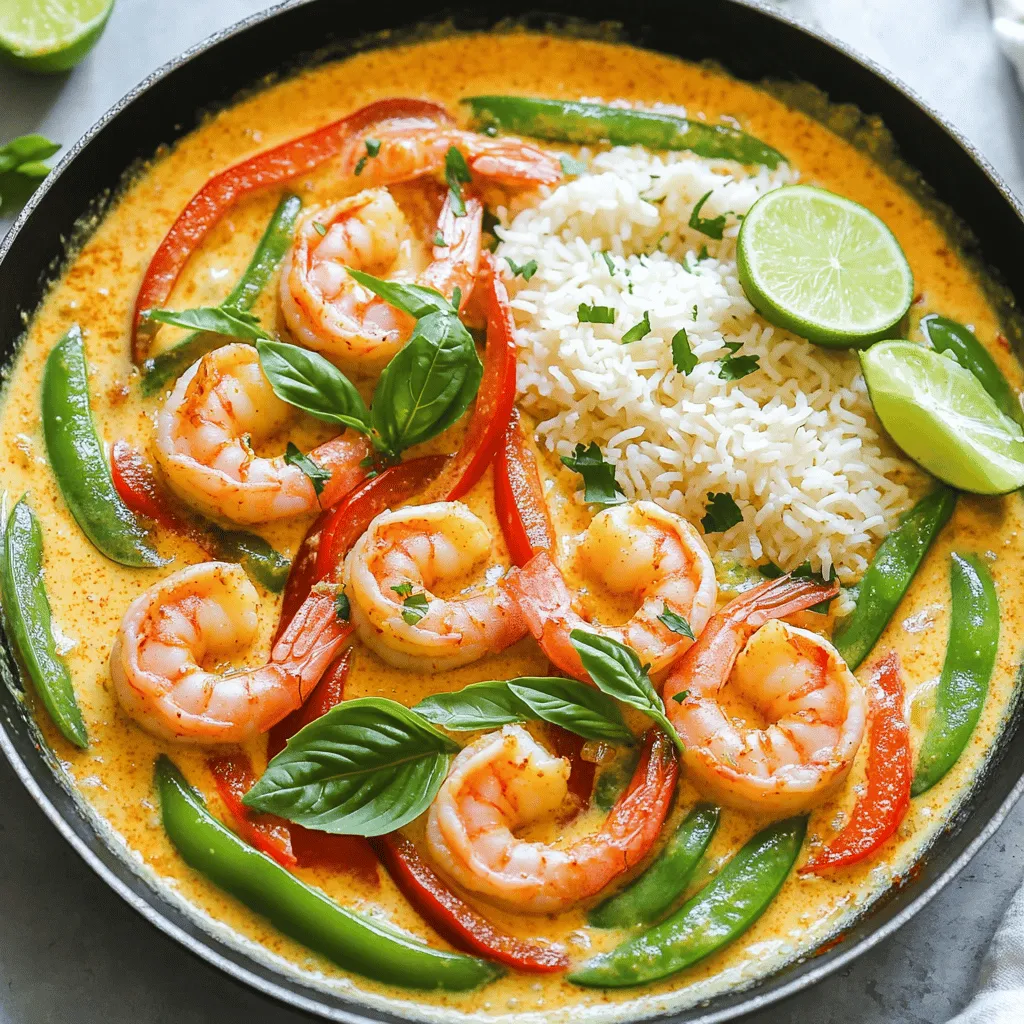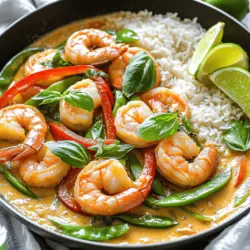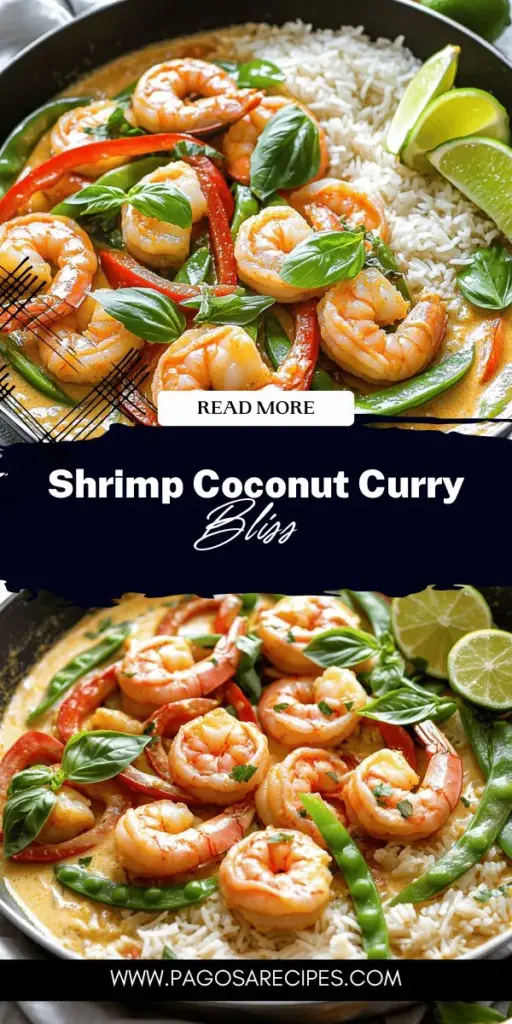Ready to dive into a bowl of Thai Shrimp Coconut Curry? This rich and flavorful delight brings together fresh shrimp, creamy coconut milk, and exotic spices for a dish that’s both comforting and vibrant. In this article, I’ll guide you through the key ingredients, cooking steps, and variations that make this meal a hit for any occasion. Let’s start the journey to your new favorite recipe!
What are the key ingredients in Thai Shrimp Coconut Curry?
The magic of Thai shrimp coconut curry comes from its rich and vibrant ingredients. The star of the dish is, of course, shrimp. I recommend using large shrimp for the best texture. They cook well and soak up flavors nicely.
Coconut milk adds creaminess and a hint of sweetness. This milk is key in Thai curry ingredients. You can find it in almost any grocery store. Red curry paste is another essential ingredient. It packs a punch and adds depth to the flavor.
Don’t forget the fish sauce! It brings a salty umami taste. If you prefer, soy sauce works as a great alternative. Brown sugar balances the heat and adds a touch of sweetness.
Fresh veggies like bell pepper and snap peas add crunch and color. They also bring vitamins to the dish. Onions, garlic, and ginger provide an aromatic base. Each bite becomes a burst of flavors.
Lastly, a splash of lime juice adds brightness, and fresh basil leaves give a fragrant finish. This combination of Thai curry ingredients makes the dish a true delight.
What shrimp is best for this recipe?
For this recipe, I suggest using large, fresh shrimp. They have a better texture and flavor. Look for shrimp that is peeled and deveined. This saves you time when cooking.
Frozen shrimp can also work. Just make sure to thaw them before cooking. You want them to cook evenly in the curry.
What alternatives can be used for coconut milk?
If you can’t find coconut milk, don’t worry. You can use almond milk or soy milk as substitutes. They will change the flavor slightly, but they still work well.
Another option is to mix regular milk with some shredded coconut. This gives a similar taste and texture. You can even try cashew cream for a nutty flavor.
Which spices enhance the flavors of Thai curry?
Several spices can boost your Thai curry’s flavor. Start with chili powder for heat. You can adjust the amount based on your taste.
Coriander and cumin work well together, adding warmth and depth. Turmeric gives a lovely golden color and earthy taste.
Fresh herbs like cilantro or basil can also enhance the dish’s flavor. Just sprinkle them on top before serving. These spices create a wonderful blend that makes your shrimp curry truly special.
How do I make Thai Shrimp Coconut Curry step by step?
Cooking Thai shrimp coconut curry is fun and simple. Let’s walk through the steps to make this delicious dish.
What are the cooking instructions for this dish?
1. Start by heating 1 tablespoon of vegetable oil in a large skillet over medium heat.
2. Add 1 sliced onion, 3 minced garlic cloves, and 1 tablespoon of minced ginger. Sauté for about 3 minutes.
3. Stir in 2 tablespoons of red curry paste. Cook for 1 to 2 minutes to bring out the flavors.
4. Pour in 1 can of coconut milk, 1 tablespoon of fish sauce, 1 tablespoon of brown sugar, and 1 tablespoon of lime juice. Mix well.
5. Add 1 sliced red bell pepper and 1 cup of snap peas. Let it simmer for about 5 minutes until the veggies soften.
6. Gently fold in 1 lb of shrimp. Cook for 4 to 5 minutes until they turn pink and opaque.
7. Taste your curry and adjust the flavor with more lime juice or fish sauce if needed.
8. Remove from heat and stir in fresh basil leaves before serving.
How can I modify the recipe for dietary preferences?
You can easily change this recipe. For a vegetarian version, replace shrimp with tofu or chickpeas. Use soy sauce instead of fish sauce for a plant-based option. You can also skip the brown sugar or use a sugar substitute to lower calories. If you want it spicy, add more curry paste or fresh chili peppers.
What tools are essential for making this curry?
To make this dish, you need a large skillet or wok. A good knife helps with slicing veggies and shrimp. Use a cutting board for safety. A measuring spoon and cup will ensure accurate ingredient amounts. Finally, a spatula is handy for stirring everything together.

What are some variations of Thai Shrimp Coconut Curry?
You can make many tasty shrimp curry variations. Each one brings its own twist. For a gluten-free shrimp curry, use tamari instead of fish sauce. This keeps the flavor but avoids gluten. You can also swap out the veggies. Try adding mushrooms or zucchini for a different texture.
If you like heat, a spicy shrimp curry is perfect. Add more red curry paste or some sliced Thai chilies. Spice can really bring the dish to life. You can even mix in different herbs like cilantro for a fresh touch.
How can I adapt the dish using seasonal ingredients?
Using seasonal ingredients can make the dish fresh and exciting. In summer, add ripe tomatoes or corn for sweetness. In fall, use butternut squash for a creamy texture. You can change the veggies based on what you find at local markets. This keeps your curry unique and flavorful.
What are some vegetarian alternatives for shrimp?
For vegetarian options, there are plenty of choices. Tofu is a great substitute. It soaks up all the delicious flavors. You can also use chickpeas or mushrooms. These add protein and a nice bite. Just cook them the same way as the shrimp.
Can I explore regional variations of Thai curry?
Yes, exploring regional variations is fun. Each part of Thailand has its own style. In the south, you might find more coconut milk and seafood. In the north, curries can be less spicy but richer in herbs. Trying these different styles can give you new ideas for your curry.
What should I serve with Thai Shrimp Coconut Curry?
Pairing Thai shrimp coconut curry with the right sides enhances the meal. First, jasmine rice is a classic choice. The rice soaks up the rich sauce and balances the flavors. You can also try coconut rice for a sweeter touch.
What are some traditional accompaniments?
For a traditional feel, serve your curry with steamed vegetables. Broccoli, carrots, or bok choy add color and nutrition. A simple cucumber salad with lime and chili adds a refreshing crunch. It cools the heat from the curry.
How can I pair the dish with suitable beverages?
When it comes to drinks, coconut water is a natural fit. It complements the curry’s flavors and hydrates. Thai iced tea is another great option. Its creamy, sweet taste balances the spice of the curry.
What are creative serving ideas for that special occasion?
For a special touch, serve the curry in hollowed-out pineapples. This adds a tropical flair and makes for a stunning presentation. You could also offer a tasting menu with small bowls of curry. This lets guests enjoy different flavors and textures in one meal.

What tips can help me make the best shrimp curry?
To make shrimp curry right, you need a few key tips.
How do I prevent overcooking the shrimp?
To keep shrimp tender, cook them on medium heat. Add them last in the cooking process. Shrimp only need four to five minutes to cook. They turn pink and opaque when done. If you cook them longer, they will get tough. That’s not what you want!
What are effective methods for enhancing flavor?
To boost the taste of your curry, use fresh herbs like basil. Fresh garlic and ginger make a big difference too. You can also add a splash of lime juice for zest. If you like heat, try adding chili flakes or fresh chili.
How can I store leftovers properly?
Storing leftover shrimp curry is easy. Place it in an airtight container. It will stay fresh in the fridge for up to three days. For longer storage, freeze it. When ready to eat, reheat on the stove or in the microwave. Avoid reheating it multiple times to keep the flavor. Enjoy your meals!
What health benefits does coconut curry offer?
Coconut curry is a tasty way to enjoy healthy meals. It brings together shrimp, vegetables, and coconut milk. This mix offers many health benefits.
Coconut milk is rich in healthy fats called medium-chain triglycerides (MCTs). These fats can help boost your energy and support heart health. It also contains vitamins like B vitamins and vitamin C. These nutrients can help keep your immune system strong.
To make a healthy shrimp curry, you can add more vegetables. Try using broccoli, carrots, or spinach. These veggies add fiber, vitamins, and minerals. They also make your dish colorful and appealing.
Thai spices like turmeric and ginger provide extra health perks. Turmeric is known for its anti-inflammatory properties. Ginger can help with digestion and reduce nausea. Using these spices can make your meal more nutritious and flavorful.
Overall, coconut curry is a great way to enjoy healthy shrimp curry options. It’s not only delicious but also packed with nutrients.
Thai Shrimp Coconut Curry combines delicious flavors and easy steps for a tasty meal. It starts with the right shrimp and spices, uses coconut milk, and has many variations. You can easily modify it for different diets and enjoy it with tasty sides. Remember the cooking tips, and you’ll have a perfect curry. Plus, this dish offers health benefits from coconut milk and spices. Enjoy making and sharing this flavorful dish; it warms both hearts and homes.



